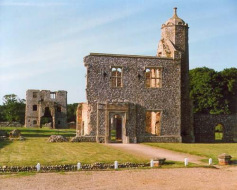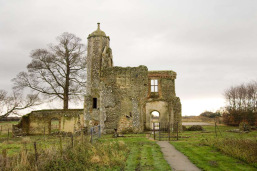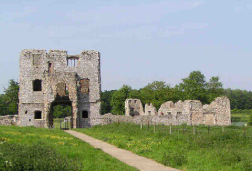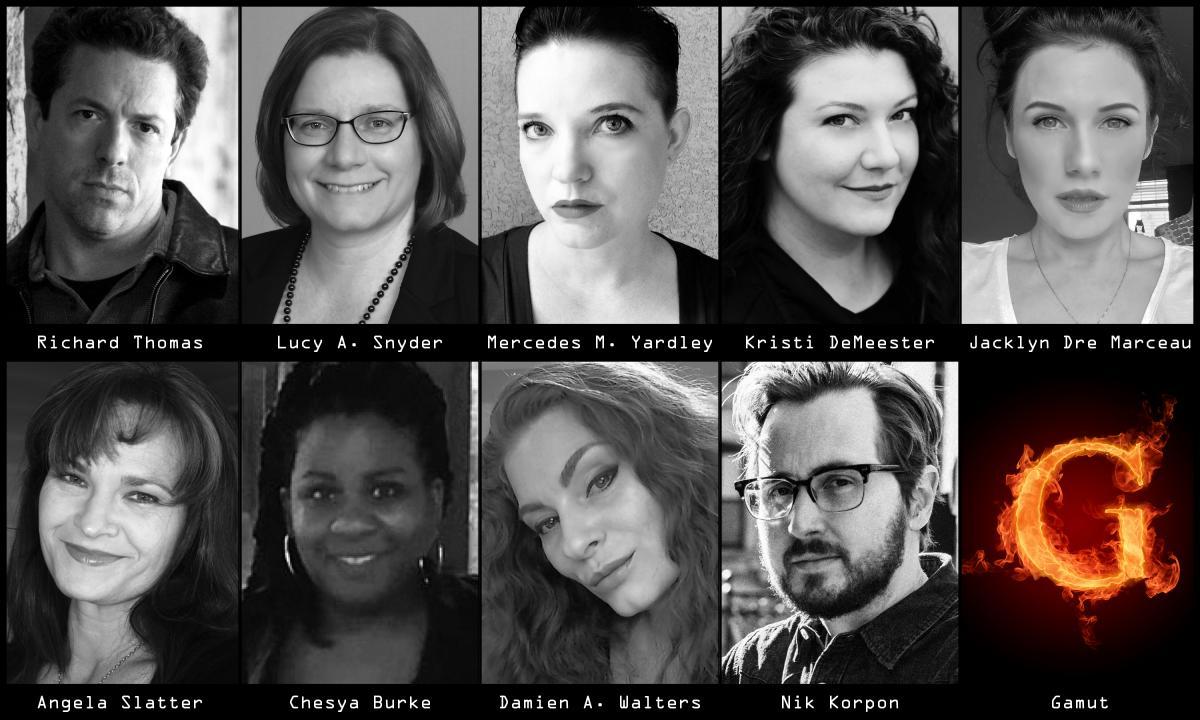A TALE OF BACONSTHORPE CASTLE!
 Hidden from the busy roads around Holt is a hint of a prosperous past; a past that comes in the form of a ruin of a once-magnificent manor house which was originally the home to the Heydon family. This ruin is a hidden gem, now owned by English Heritage; the guardians of not only what remains of brick, stone, flint and mortar, but of a place that boasts a very curious caretaker – that of a spectral sentry!
Hidden from the busy roads around Holt is a hint of a prosperous past; a past that comes in the form of a ruin of a once-magnificent manor house which was originally the home to the Heydon family. This ruin is a hidden gem, now owned by English Heritage; the guardians of not only what remains of brick, stone, flint and mortar, but of a place that boasts a very curious caretaker – that of a spectral sentry!
It is Baconsthorpe Castle of which I speak, a peaceful place standing proud in the middle of open meadows and farmland with an impressive moat and lake offering an image of its lost grandeur which once was lent to this gentle corner of Norfolk. What meets the eye is also a stony reminder of how far one can fall from grace.
 The Heydons began building work on the fortified manor house in 1450, adding extensions as their wealth grew. The person who started the whole project was lawyer, Sir John Heydon who was born the son of William Baxter, a peasant in Heydon. It is thought that Sir John changed his family surname to his village name to disguise his humble beginnings. In time, Sir John Heydon was appointed Recorder of Norwich in 1431, but soon became so unpopular with townsmen that he was dismissed as Recorder by May 1437; he was also accused of giving the City’s documents to Norwich Cathedral priory during a dispute. It was clear that John was, by nature and profession, an unscrupulous lawyer, hard man and opportunist; as an old Norfolk rhyme states: “There never was a Paston poor, or a Heydon a coward.” It also seemed to matter not to John that there was always a possibility that he may need those around him to help him see off enemies! One of these was Lord Moleynes whom John was to incite when he laid claim to the Paston Estate at Gresham, a claim that resulted in Margaret Paston and a dozen retainers being attacked by a mob of around 1,000. John also clashed with the Paston’s patron, Sir John Fastoff in disputes of property.
The Heydons began building work on the fortified manor house in 1450, adding extensions as their wealth grew. The person who started the whole project was lawyer, Sir John Heydon who was born the son of William Baxter, a peasant in Heydon. It is thought that Sir John changed his family surname to his village name to disguise his humble beginnings. In time, Sir John Heydon was appointed Recorder of Norwich in 1431, but soon became so unpopular with townsmen that he was dismissed as Recorder by May 1437; he was also accused of giving the City’s documents to Norwich Cathedral priory during a dispute. It was clear that John was, by nature and profession, an unscrupulous lawyer, hard man and opportunist; as an old Norfolk rhyme states: “There never was a Paston poor, or a Heydon a coward.” It also seemed to matter not to John that there was always a possibility that he may need those around him to help him see off enemies! One of these was Lord Moleynes whom John was to incite when he laid claim to the Paston Estate at Gresham, a claim that resulted in Margaret Paston and a dozen retainers being attacked by a mob of around 1,000. John also clashed with the Paston’s patron, Sir John Fastoff in disputes of property.
If turbulent relationships was not enough, John Heydon, during the intensive Wars of the Roses, often switched political allegiances to serve his own means. However and despite being also linked to extortion, duplicity and underhand tactics, John Heydon proved to be an astute survivor. At least two of those close to him were beheaded but John managed to not only stay alive but managed to retain his seat in Baconsthorpe, his property portfolio and his wealth.
 The Heydons lived at Baconsthorpe for 200 years, their fortune built on the wool industry. But the family were poor estate managers and Christopher Heydon, who died in 1579, left his son William with growing debts. It was him and his eldest son Christopher who were the ones who wrought the family’s downfall; both were hot-tempered and clashed badly. Christopher lived at Saxlingham Hall with his wife Lady Mirabel. William was forced to sell off parts of the manor house.
The Heydons lived at Baconsthorpe for 200 years, their fortune built on the wool industry. But the family were poor estate managers and Christopher Heydon, who died in 1579, left his son William with growing debts. It was him and his eldest son Christopher who were the ones who wrought the family’s downfall; both were hot-tempered and clashed badly. Christopher lived at Saxlingham Hall with his wife Lady Mirabel. William was forced to sell off parts of the manor house.
In the late 16th or early 17th century, an ornamental mere was created to the east of the moat and formal gardens were created, but by the mid-17th century, the insolvency of successive Heydons forced them to demolish most of the castle and sell the stone, some of which ended up at Felbrigg Hall. The remains of the castle was sold to merchant Daniel Bridges in 1673. The gatehouse was eventually converted into a private dwelling and occupied until 1920 when it collapsed and the building left to decay.
 There is so much more to the history of the Heydons and all of it would be very interesting but, unfortunately, there is not enough space here to document it. However, there is another side to Baconsthorpe that not many know about; it may surprise and intrigue you. It is that when visitors come to the castle and wander through the shattered remains to the moat, some will witness the silence broken by the unmistakeable sound of stones breaking the still waters – stones clearly thrown from some height! This and the sight of ripples spreading to either side and along the moat may well cause confusion with a few, but on turning inward to the ruin they will see clearly from where the stones were thrown. Not only that, but they would not fail to catch sight of a ghostly sentry or medieval soldier standing on the castle walls, throwing these stones – as if to pass the time maybe? A few visitors may well be startled but, always remember, no one has ever reported feeling threatened by this stone-throwing spirit!
There is so much more to the history of the Heydons and all of it would be very interesting but, unfortunately, there is not enough space here to document it. However, there is another side to Baconsthorpe that not many know about; it may surprise and intrigue you. It is that when visitors come to the castle and wander through the shattered remains to the moat, some will witness the silence broken by the unmistakeable sound of stones breaking the still waters – stones clearly thrown from some height! This and the sight of ripples spreading to either side and along the moat may well cause confusion with a few, but on turning inward to the ruin they will see clearly from where the stones were thrown. Not only that, but they would not fail to catch sight of a ghostly sentry or medieval soldier standing on the castle walls, throwing these stones – as if to pass the time maybe? A few visitors may well be startled but, always remember, no one has ever reported feeling threatened by this stone-throwing spirit!
So be at ease, for this experience is only a further reminder that a spectral sentry was, at one moment in the distant past, detailed to be on guard at Baconsthorpe. There is every possibility, as things stand, that this lone soul may well stay there until such time as a counter order is issued from the appropriate authority for him to stand down. Until then……………….!
Norfolk Tales & Myths. (written & adapted by Haydn Brown)Share this:





